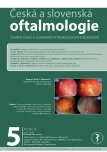ANALYSIS OF CORNEAL ANTEROPOSTERIOR RATIO OF OPTICAL POWER USING OCT
Authors:
M. Fůs; Š. Pitrová
Authors‘ workplace:
České vysoké učení technické v Praze, Fakulta biomedicínského inženýrství, Kladno
Published in:
Čes. a slov. Oftal., 78, 2022, No. 5, p. 228-232
Category:
Original Article
doi:
https://doi.org/10.31348/2022/23
Overview
Aims: The aim of the study was to analyse the values of the anteroposterior corneal optical power ratio (AP ratio), to compare the resulting values with those of theoretical models of the eye, and to define the effect of using an individual ratio value on the approximation of the total corneal power.
Material and Methods: A total of 406 eyes were included. Each patient underwent an OCT (RTVue XR) examination, according to which the AP ratio of the cornea was determined, as well as the biometric parameters of the eye (Lenstar LS900). The correlation between the biometric parameters of the eye and the individual AP ratio values was evaluated using Pearson’s correlation coefficient. In the analysis, the AP ratio results were compared with selected schematic models of the eye. Using Gaussian equations, a theoretical calculation of the total corneal optical power (KG) was performed, by fitting the AP ratio value and comparing it with the actually measured total corneal power (TCP).
Results: The mean value of the individually determined AP ratio was 1.17 ±0.02. The most frequently represented interval (33.74 %) was 1.17 to 1.18 AP ratio values, with the vast majority of eyes (79.56 %) in the range of 1.15 to 1.20. Individual values of total corneal optical power were statistically significantly different (p < 0.05) from the theoretical values of TCP (except in the Liu-Brennan eye model, where p = 0.06). The lowest mean difference of values was found for the Navarro schematic model. The dependence of the measured AP ratio values and biometric parameters reached a moderate negative correlation (r = -0.50 for p < 0.05) with the parameter corneal posterior surface curvature (Rp), as well as a weak negative correlation with limbal diameter WtW (r = -0.26 for p < 0.05) and a weak positive correlation with central corneal thickness CCT (r = 0.17 for p < 0.05).
Conclusion: The assumption of a constant value of the AP ratio according to the selected schematic models of the eye is statistically significantly different from the actual measured values and was defined to have only a negative weak correlation with the size of the limbus diameter. Using the resulting average value of the determined AP ratio (1.17 ±0.02), a lower difference between real and calculated total corneal optical power was achieved.
Keywords:
corneal AP ratio – posterior corneal radius – total corneal power – optical cohoerence tomography
Sources
1. Koch DD. The posterior cornea: hiding in plain sight. Ophthalmology. 2015 Jun;122(6):1070-1071. doi: 10.1016/j.ophtha.2015.01.022
2. Fam HB, Lim KL. Validity of the keratometric index: large population- based study. J Cataract Refract Surg. 2007 Apr;33(4):686-91. doi: 10.1016/j.jcrs.2006.11.023
3. Kaschke M, Donnerhacke KH and Rill MS. Optical devices in ophthalmology and optometry: technology, design principles and clinical applications. Weinheim, Bergstr: Wiley-VCH, 2013. ISBN 978-352-7410-682.
4. Gullstrand A. In Physiologische Optik; H. von Helmholtz; Ausgabe Band 1 Voss:Hamburg, 1909, Vol. 3, pp. 350-358.
5. Le Grand Y, El Hage, SG. Physiological Optics; Springer-Verlag: Berlin; 1980.
6. Navarro R, Santamaría J, Bescós J. Accommodation-dependent model of the human eye with aspherics. Journal of the Optical Society of America. 1985 Aug;2(8):1273-81. doi: 10.1364/ josaa.2.0012737
7. Liou, H, Brennan, NJ. Journal of the Optical Society of America. A 1997, 14, 1684-1695.
8. Ho JD, Tsai CY, Tsai RJ, Kuo LL, Tsai IL, Liou SW. Validity of the keratometric index: evaluation by the Pentacam rotating Scheimpflug camera. J Cataract Refract Surg. 2008 Jan;34(1):137-45. doi: 10.1016/j.jcrs.2007.09.033
9. ARTAL, Pablo. Handbook of visual optics. Boca Raton: CRC Press, Taylor & Francis Group, 2017. ISBN 978-1-4822-3785-6.
10. Machatá L, Fus, M, Pitrova S. Analysis of Corneal AP Ratio Using OCT. In: XII. National student conference of optometry and orthoptics with international participation. Brno: Národní centrum ošetřovatelství a nelékařských zdravotnických oborů, 2021. p. 57- 63. 2. ISBN 978-80-7013-611-9.
11. Tang C, Wu Q, Liu B, Wu G, Fan J, Hu Y, Yu H. A Multicenter Study of the Distribution Pattern of Posterior-To-Anterior Corneal Curvature Radii Ratio in Chinese Myopic Patients. Front Med (Lausanne). 2021 Dec 20;8:724674. doi: 10.3389/fmed.2021.724674
12. Montalbán R, Piñero DP, Javaloy J, Alió JL. Scheimpflug photography- based clinical characterization of the correlation of the corneal shape between the anterior and posterior corneal surfaces in the normal human eye. J Cataract Refract Surg. 2012 Nov;38(11):1925- 1933. doi: 10.1016/j.jcrs.2012.06.050
13. Savini G, Hoffer KJ, Lomoriello DS, Ducoli P. Simulated Keratometry Versus Total Corneal Power by Ray Tracing: A Comparison in Prediction Accuracy of Intraocular Lens Power. Cornea. 2017 Nov;36(11):1368-1372. doi: 10.1097/ICO.0000000000001343
14. Dubbelman M, Sicam VA, Van der Heijde GL. The shape of the anterior and posterior surface of the aging human cornea. Vision Res. 2006 Mar;46(6-7):993-1001. doi: 10.1016/j.visres.2005.09.021
15. Hasegawa A, Kojima T, Yamamoto M, Kato Y, Tamaoki A, Ichikawa K. Impact of the anterior-posterior corneal radius ratio on intraocular lens power calculation errors. Clin Ophthalmol. 2018 Aug 27;12:1549-1558. doi: 10.2147/OPTH.S161464
16. Tang M, Chen A, Li Y, Huang D. Corneal power measurement with Fourier-domain optical coherence tomography. J Cataract Refract Surg. 2010 Dec;36(12):2115-2122. doi: 10.1016/j. jcrs.2010.07.018
Labels
OphthalmologyArticle was published in
Czech and Slovak Ophthalmology

2022 Issue 5
Most read in this issue
- SARS-COV-2 PANDEMIC FROM THE OPHTHALMOLOGIST`S PERSPECTIVE. A REVIEW
- CHELATION OF BAND KERATOPATHY IN LONG-TERM MONITORING
- ATYPICAL FORMS OF EYE TOXOPLASMOSIS IN CHILDHOOD. CASE REPORTS
- PRIMARY OPEN-ANGLE GLAUCOMA DUE TO MUTATIONS IN THE MYOC GENE
